Seeing red? If you’re looking at your homegrown tomatoes, I hope they are a bright, cheery red color as they’re ripening on the vine.
And yet, I know that even experienced gardeners have times when their plants are nearing that all-important harvest date and the fruit is still hard and green.
At any time in the growing season, but especially if a killing frost is bearing down, your stress increases by the minute. What’s a gardener to do?
I’m going to help you out here, with several ways to encourage tomatoes to turn red on the vine.
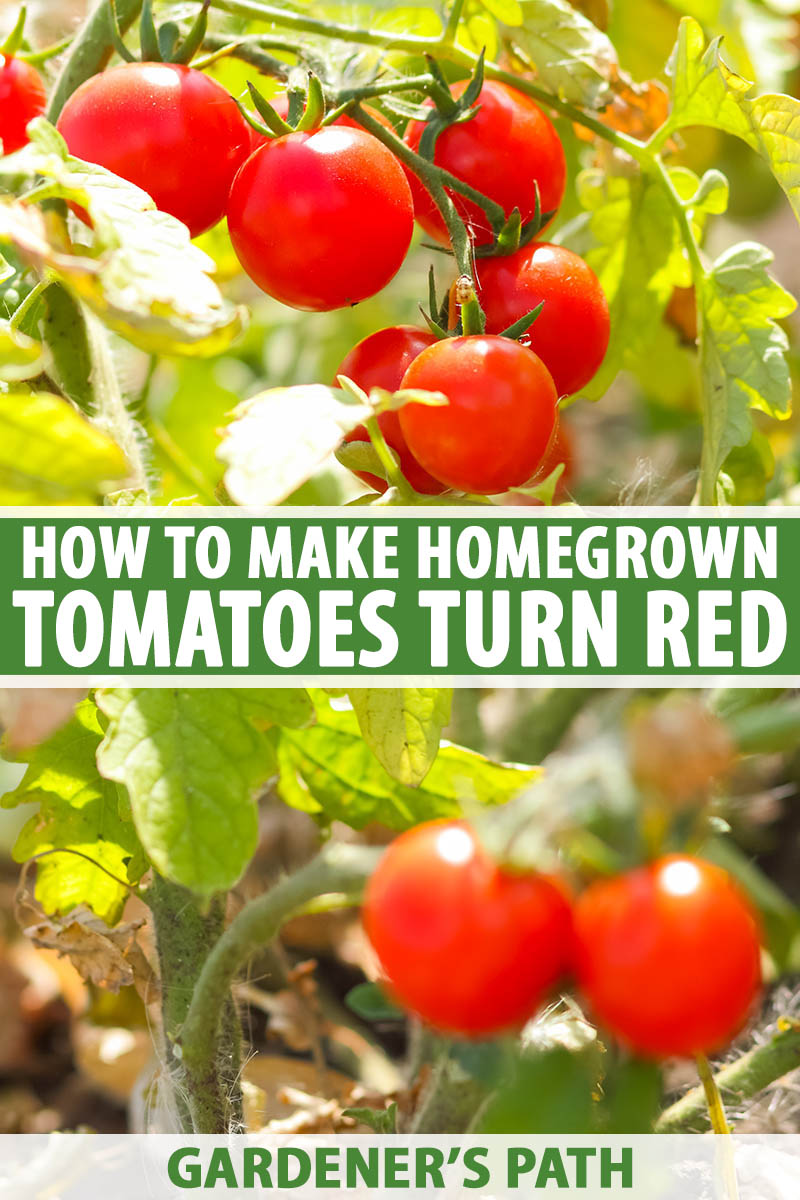
We link to vendors to help you find relevant products. If you buy from one of our links, we may earn a commission.
Some of my tips will only help you next season, when you’re back to selecting your dream heirloom varieties and planting your crop.
But there are also solutions for those in the “Ack! The tomatoes are green and autumn’s arriving” camp.
And I’ll encourage you to keep trying even if you have to pick every last green fruit, even the cherry ones, and try to ripen them indoors.
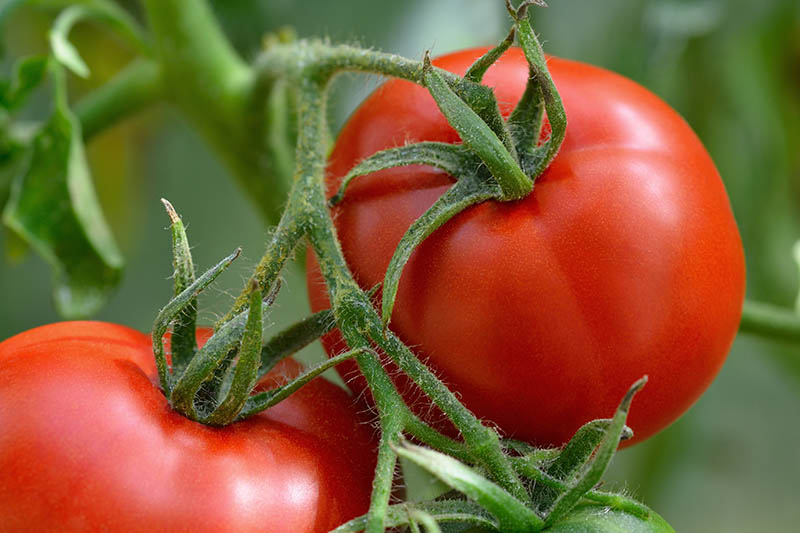
After all, red tomatoes are a delight for the eyes, and a treat for the palate. It would be awful to tend your plants for the 70-100 days most take to produce ripe fruit and then come up short at the end of the season.
These are the aspects that I’ll cover:
What You’ll Learn
Why Are Ripe Tomatoes Commonly Red?
If your plants are producing fruit that isn’t a vivid crimson, it’s comforting to know that lots of gardeners have that complaint. After all, we all want red tomatoes!
But did you ever stop to ask why these fresh tomatoes us home growers find so desirable are red?
There’s a scientific explanation, and knowing about it can help you with your own fruits that stay stubbornly green when you want them to be a nice red color.
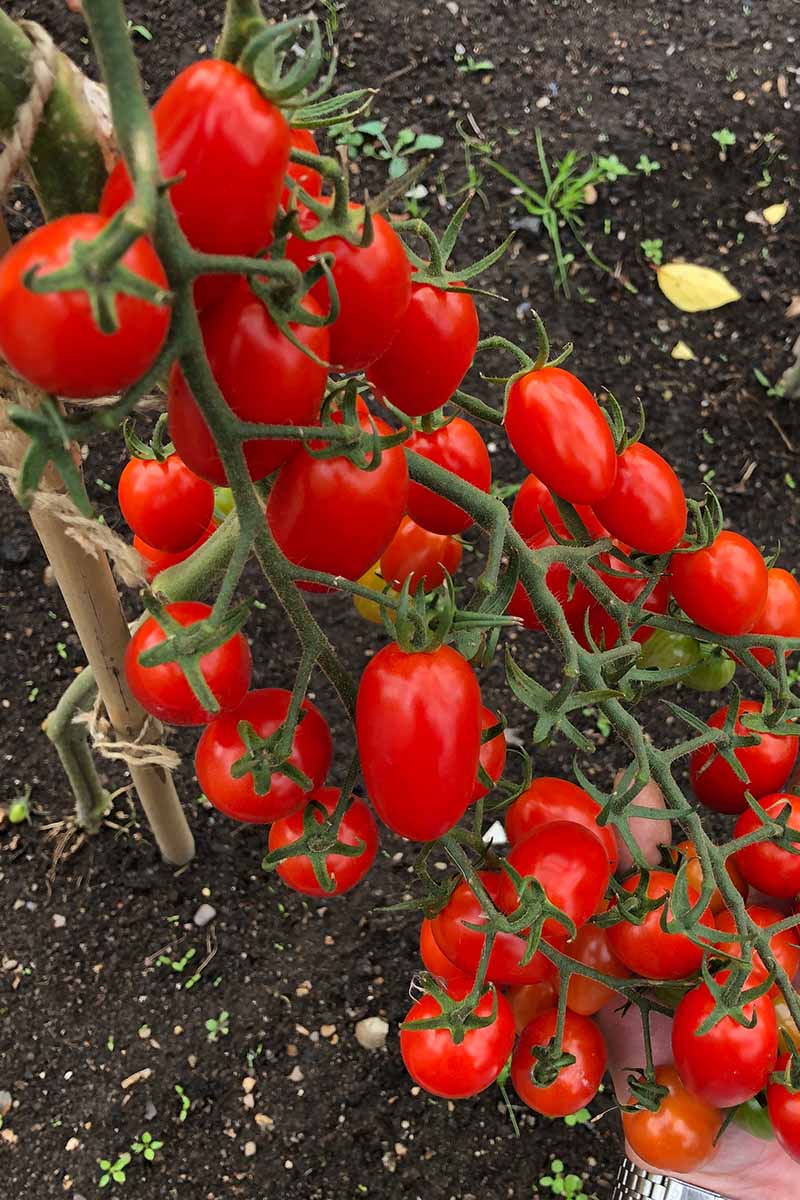
When the fruits are green, they get this color from chlorophyll. When they progress from maturity to ripening, they produce a naturally-occurring hormone called ethylene.
The ethylene initiates the ripening process, triggering the fruit to start turning red and also to soften.
As for the timeline on which this occurs, it usually takes a tomato plant about three weeks from transplant to get tall enough to flower, about 12 to 18 inches in height for most cultivars.
From there, if all goes well, it usually produces green fruit that grow to maturity in another 20 to 30 days.
Once they’re full size, it will take another 20 to 30 days, on average, to ripen and change color from green to yellow to red.

Cherry and grape varieties can ordinarily produce tiny, ripe, red fruit in 25-30 days total from bloom to harvest.
If you do the math and that’s not what’s happening in your garden, it’s time to do some more sleuthing and determine why your crops aren’t ripening on the vine.
4 Reasons Your Tomatoes Won’t Ripen on the Vine
As I know from experience on more than one occasion when my vines were stubbornly holding on to hard, green fruit, you can’t take this phenomenon personally.
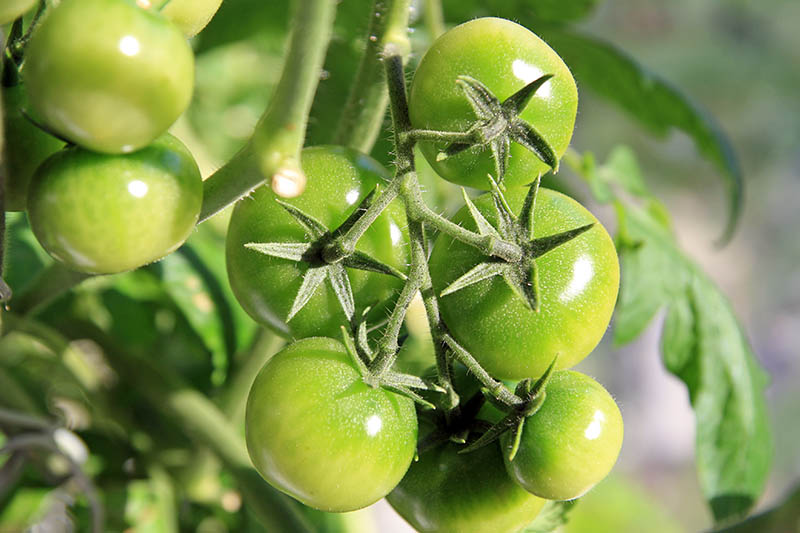
Instead, survey your plants and garden to see if one of these four factors might be affecting their ability to ripen into a luscious red:
1. Temperatures Are Too Warm
If your tomatoes seem permanently paused on green and it’s still warm, heat could be the cause.
It’s hard to believe this about such easy-to-grow garden vegetables, but they can be a bit temperature sensitive. Along with ethylene, temperature dictates when the pigment will begin to change.

The optimal temperature for tomatoes to turn red is 68-77°F. A little warmer is okay, but when temperatures exceed 85-90°F, the ripening process grinds to a halt, or at least slows down.
If the temperature is too warm, your fruits may look either greenish orange or pale green on the vine, to the point of being almost white. But alas, not red.
Fortunately, there is good news:
If it’s just too hot for the pigments to develop, you will likely have plenty of time in the growing season left to cope with the slowdown.
2. Temperatures Are Too Cool
On the flip side, cooler weather can also put a stop to those desired changes that will turn your crops a rosy shade. Again, you’re seeking that optimal 68-77°F range for them to ripen to a sporty red hue.

If the temps dip to 55°F, add at least a week or maybe two to the average time it would take the fruit to ripen if it were 65°F out, based on your seed packets or plant tags.
What to do if the weather should get cooler still?
If your area sustains nighttime temps lower than 50°F paired with daytime temps under 60°F, and this lasts for two weeks or more, the transformation to that lovely red shade that you’re going for will halt completely.
Nor will your plants set fruit to ripen when the air is colder than 50°F. You might get some green fruits if your plants are trying to set fruit in 50-55°F weather, but count on them to also develop odd shapes and soft spots.
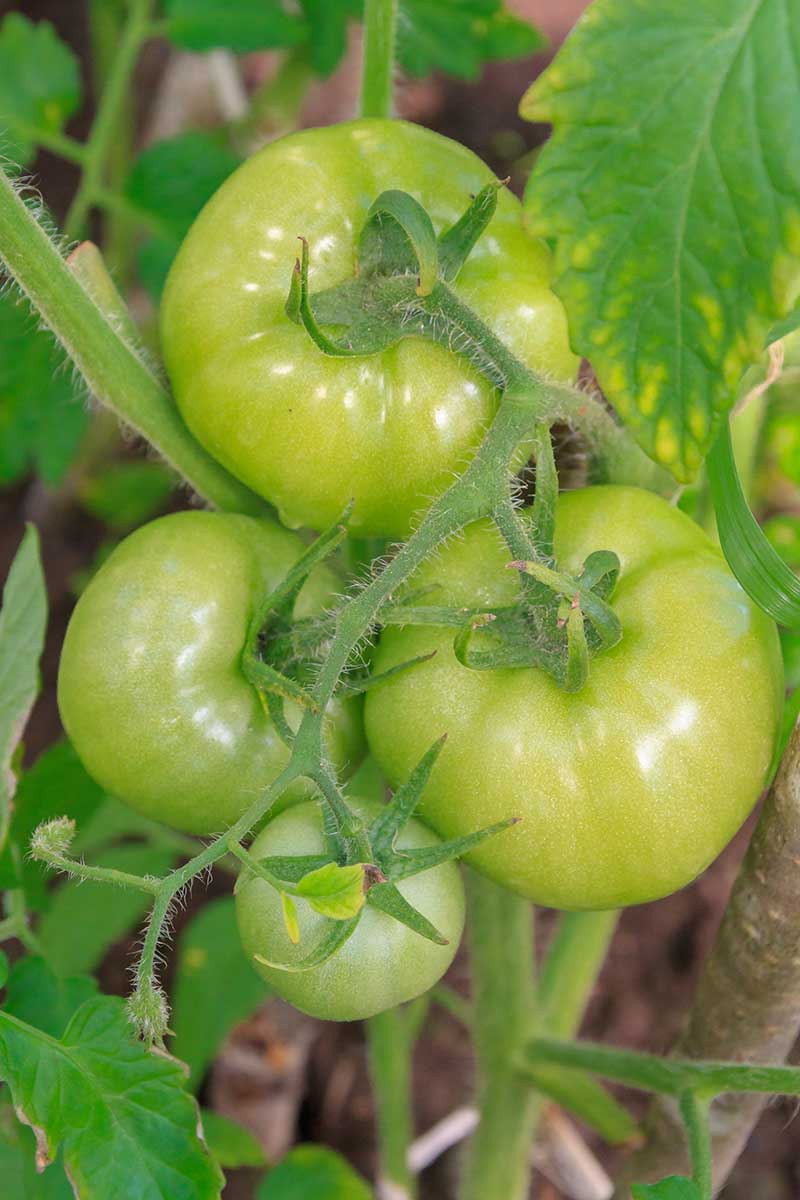
The solution to getting those with green fruits through a chilly snap is straightforward:
Protect the plants with row cover, an old bed sheet, or even a plastic tarp.
Once a tomato plant is hit with freezing temperatures, you can banish any hope for the green fruits to come to harvest, and for the plants themselves. Unfortunately, you won’t be able to salvage any fruit at that point.
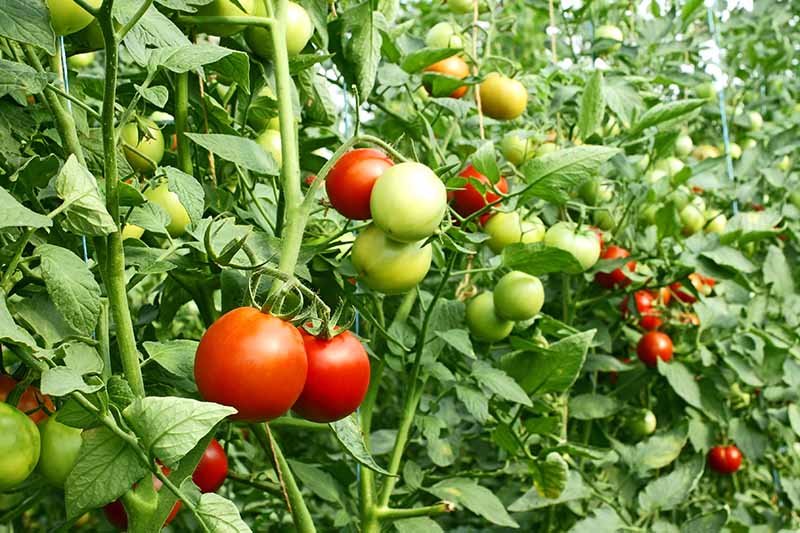
But if there’s no end in sight to the chilly temps, or reliable sources are predicting frost, you can still triage the fruit that’s already on your plants. You may be able to bring any that have at least begun to show signs of growing softer or changing color inside to ripen.
A little later in this guide, I’ll provide some instructions for saving green tomatoes before a freeze, and turning them red indoors.
But that’s your last resort. Before this takes place, review the possible reasons why your fruits aren’t ripening on the vine, and try to solve these issues before frost arrives.
3. Wrong Variety for Your Growing Season
If you’re growing what you hoped would be juicy red tomatoes but they’re still green, and frost is approaching, you may have chosen an inappropriate variety for your area.
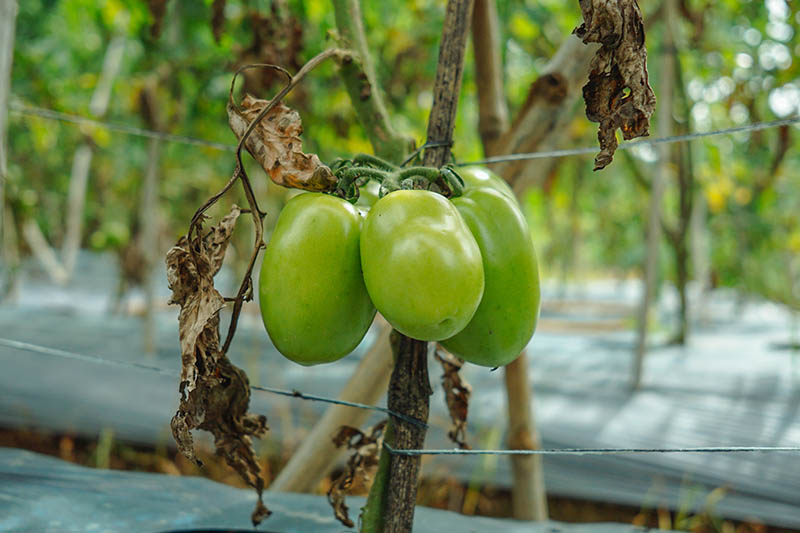
When you live in a place where there’s a short growing season, it’s important to select short-season cultivars so the green fruit has time to grow to its full size and turn red before temperatures drop below 50°F.
A few of the best short-season varieties include ‘Early Girl,’ which produces ripe, red fruit about 50 days after transplant, and ‘Juliet,’ a red grape cultivar that’s ready to harvest about 60 days from transplant.
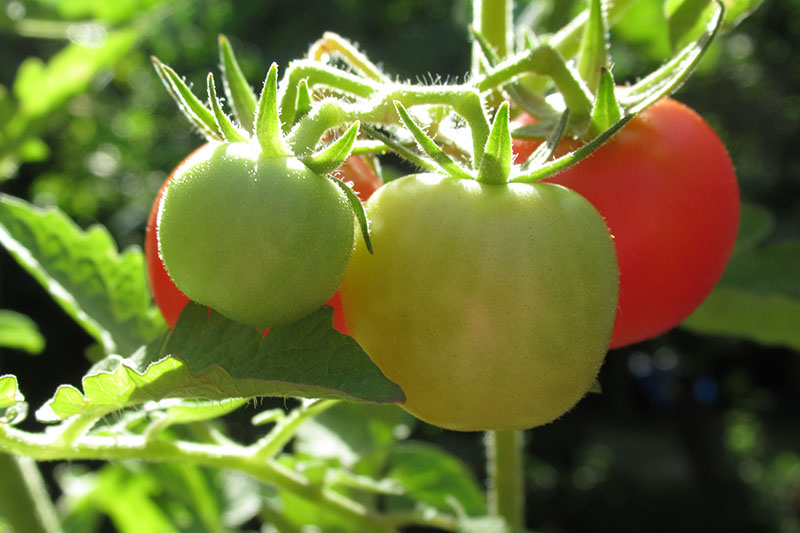
Sometimes, even a reliable local nursery will stock seedlings of a variety that won’t produce ripe fruit reliably before the first frost arrives in your area.
Make sure to research how long your chosen cultivars will take to mature before you buy transplants, and do the same if you’re going to order seeds or plants from a reputable seller.
4. Stressed or Overgrown Vines
Like every living thing, tomato plants only have so much energy. If they’re using too much to grow leaves and flowers, they may not have any energy left to turn green fruit red.
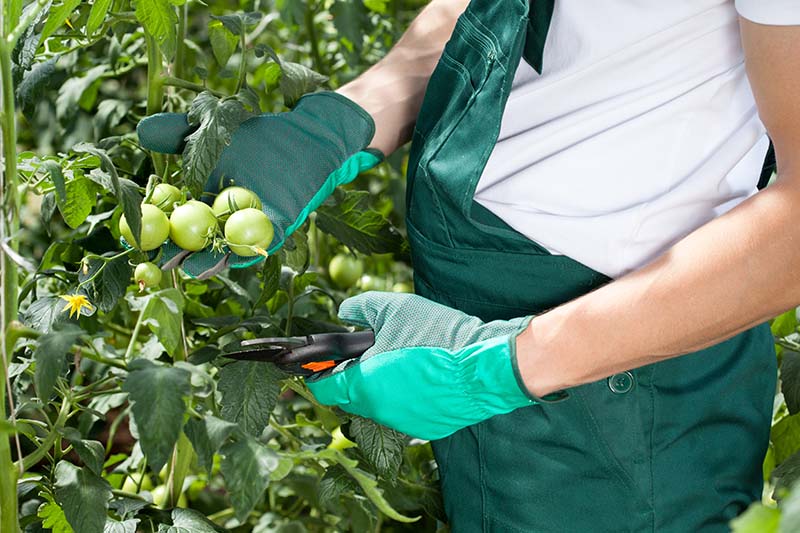
To make sure this doesn’t happen on your vines, some timely pruning is in order six weeks before the first expected frost in your area.
Use scissors or shears to trim your vines, cutting them back to the point where the stems are holding mature green fruit.
This aids ripening in two ways:
- It discourages the plant from blossoming further, which takes away valuable energy.
- It improves airflow, which can prevent fruits and plants from being infected with disease.
You can also try to encourage those green fruits to turn red by pruning your plants’ roots.
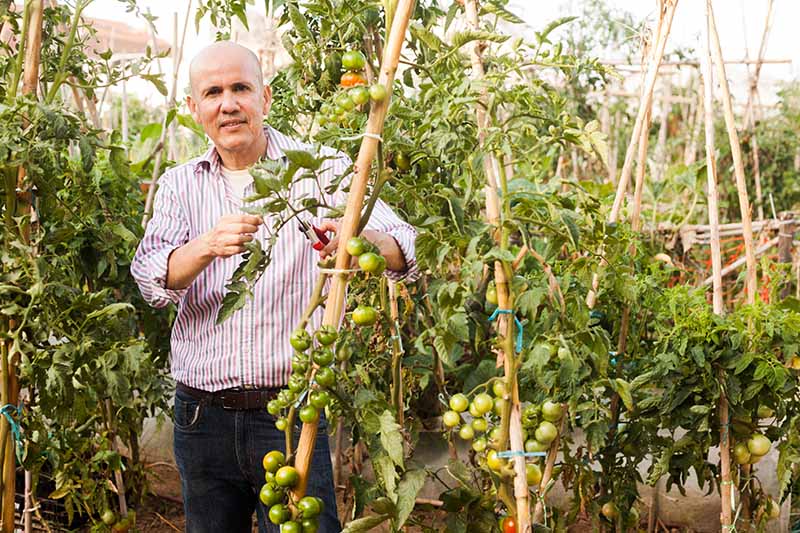
Doing this is pretty straightforward:
You use a shovel to cut the roots below the soil, aiming about one foot away from the main stem of each plant.
Slice about 6 inches into the soil in four or five spots around the plant. This should sever the roots in those spots, which can prevent the plant from growing taller and blossoming, and instead turn its energies to ripening the existing fruit.
When You Should Compost Green Tomatoes
This is one of the many reasons why I love growing my own fruits and vegetables. So much good can come from this, even from produce that doesn’t make it to harvest.
Green tomatoes are a great example. If you’ve chosen a variety that won’t ripen on the vine in time, or an unexpected bout of chilly weather strikes late in the growing season, you can still get some value from the green fruit by adding them to your compost pile.

No, it’s not as satisfying as sitting down to a harvest of vine-ripened, homegrown produce. But it’s comforting to know that at least your efforts still yielded some nutritious compost components.
Where do you draw the line between identifying green tomatoes on the vine that can be ripened indoors and those you should add to the compost?
Any green ones that are still hard should be tossed onto the pile or into the bin. You only want to spend the time and energy on indoor ripening if it’s what us gardeners call “mature green.”
Look for a glossy green surface, and squeeze the tomato gently. It should be at least a little soft and maybe streaked with a bit of yellow, indicating that ripening has begun on the vine.
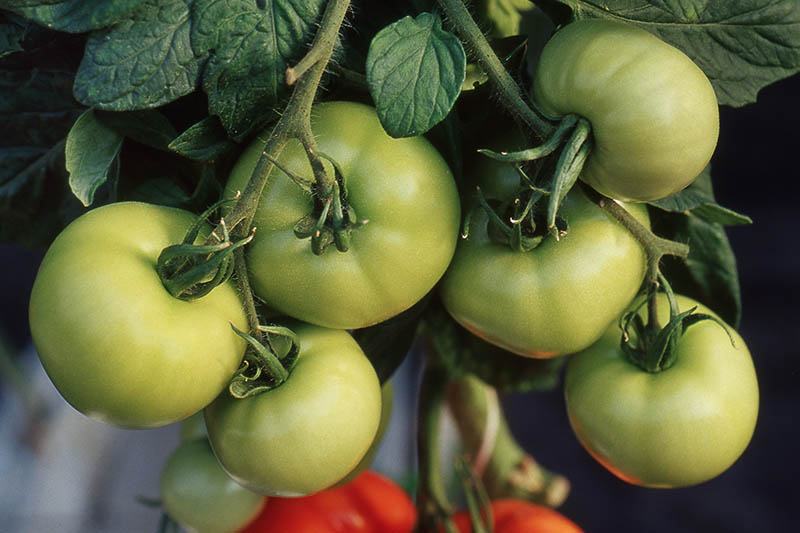
If they are hard, with a flat, matte green color, it’s time to give up and use them to enrich the compost for next year’s planting.
This goes double for green grape or cherry varieties that won’t ripen on the vine. No amount of nurturing indoors will make them turn red, and they’re lots of trouble to pick individually and bring indoors.
And skip the heroic measures for any unripe fruits that are marred or misshapen. They’ll most likely shrivel indoors, and would do far better in the compost.
If you don’t have a compost pile or bin at the ready, tomatoes that won’t turn red offer the perfect opportunity to start this earth-friendly habit.
Read our handy guide on composting to learn more about all the things you can add at the end of the vegetable growing season.
How to Ripen Green Tomatoes Indoors
I’m not gonna lie. When you have to resort to trying to make your unripe harvest turn red indoors, you’re not going to get the same great taste as you would with vine-ripened homegrown fruit.
For one thing, while you can make them ripen a bit indoors, you can’t make it produce the sugars that make homegrown tomatoes taste so great. You can encourage your green harvest to produce more ethylene, but that doesn’t produce sugar.
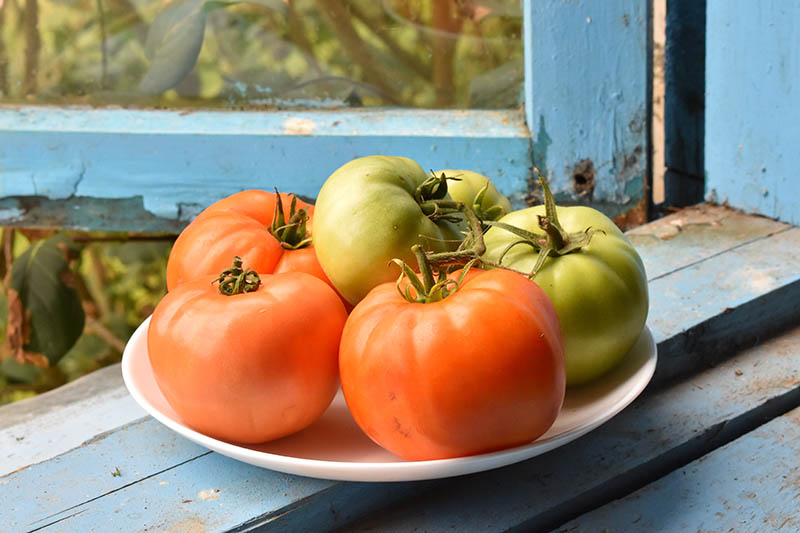
Still, it’s worth a shot if you have “mature green” tomatoes on your vines. Don’t expect luscious, dripping slicers, but do count on red fruit that still tastes much better than the commercial variety.
Instead of eating them in, say, a caprese salad, you’ll probably be happier using them in homemade salsa or on tacos, or simmered into soups.
Are you growing your plants in containers? The simplest way to try to turn those red is to bring the whole potted plant indoors, where it’s warmer.
If you’ve got the space and the muscle, you can also uproot entire vines full of mature green fruit and hang them upside down from rafters in the garage or basement until fruits are red and ripe.

Make sure some of the roots are still attached, and hang the vines in an area that’s well lit but not in direct sunlight.
Wherever you move your potted or uprooted plants, make sure the temperature there is consistently in the 50-70°F range.
You can also pick them individually to ripen indoors. If you set them on a countertop, they’ll eventually produce enough ethylene to turn red and to soften.
If you get impatient, you can also set them in a bag with a ripe tomato to speed up their ethylene production. If you add a slice of banana or apple to the mix, it will give off ethylene gas and speed the ripening process even more.
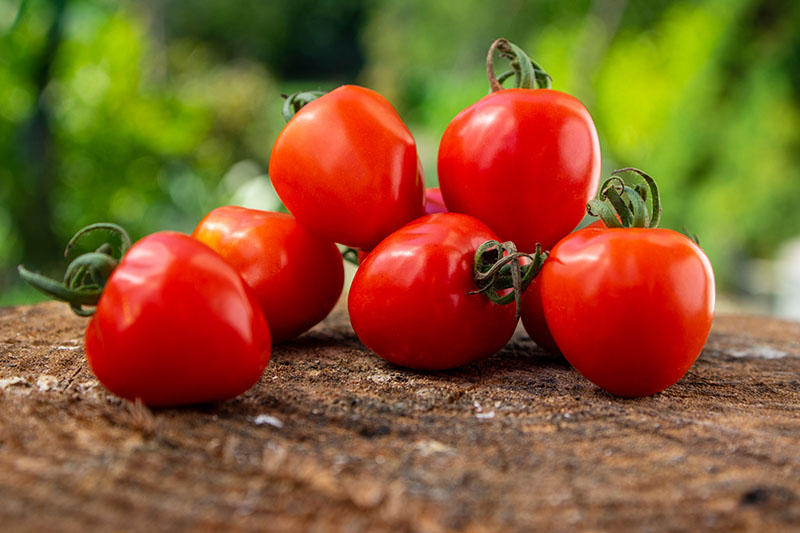
You’ll have to be vigilant, though, and remove each one that turns red as it ripens. Otherwise, you’ll end up with rotted fruit oozing over the still-hard green fruit. (I’ve seen this with my own eyes.)
And whatever you do, resist the temptation to stash your ripening tomatoes in the fridge. They need to turn red at room temperature, or they’ll lose every bit of their tomatoey flavor.
Love Is Like a Red, Red Tomato
When you make all that effort to grow your own luscious tomatoes, it’s only fair that they be a delicious, eye-appealing red at harvest time.
If you didn’t have time for even a last-minute effort to make your crop turn red on the vine, remember, there’s always next year.
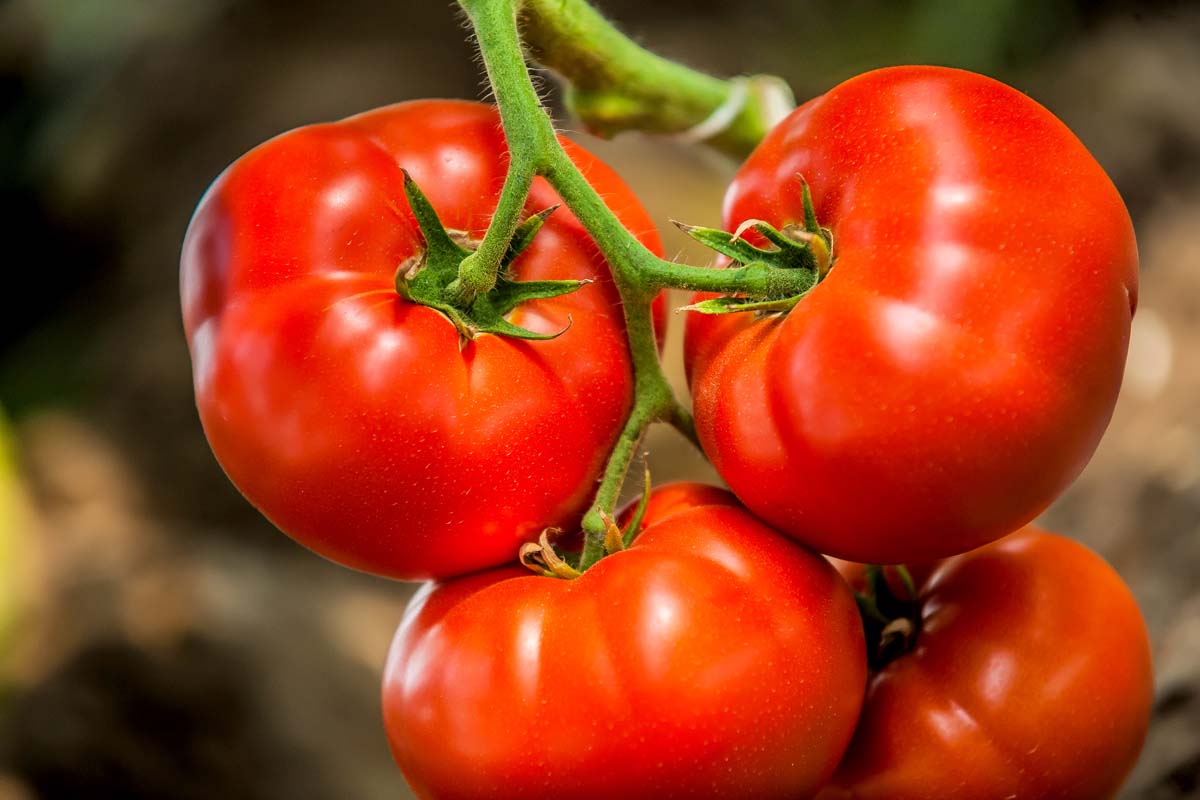
It’s never too early to start thinking about the best selections for red tomatoes in your area, or to start preparing your garden for a red harvest when next year’s plants mature.
If you’ve got a story about your own stubborn crop refusing to ripen on the vine, please share it in the comments section below, along with any questions you may have.
To learn more about growing tomatoes in your garden, you’ll find even more helpful info here:
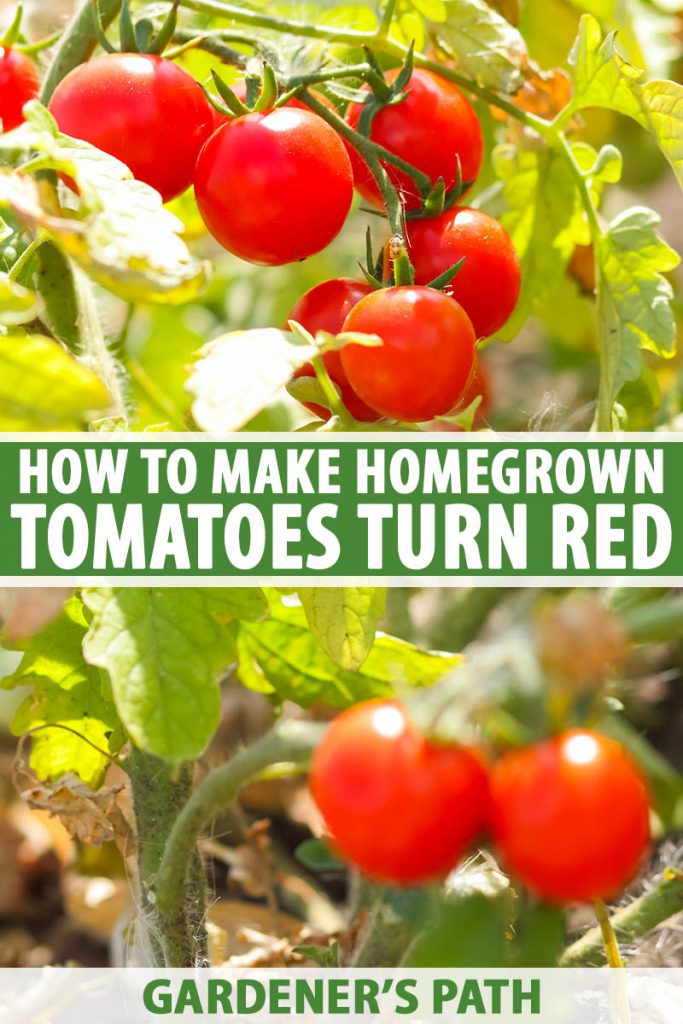

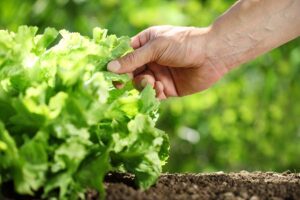
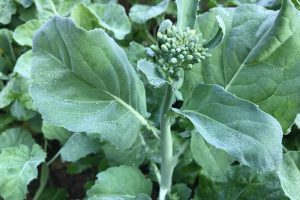
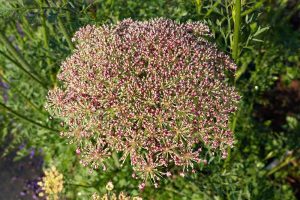
Thank you Rose, this is an excellent article.
Wow, thanks Tomato lover. Can’t wait to get in gear for this year.
What tomatoes are best for northern Illinois…?
In northern Illinois, you’re probably in USDA Hardiness Zone 4 or 5. Most varieties of tomato should do well there, as long as they’re planted at the right time for your zone and get plenty of sun. See our roundups of heirlooms, hybrids, cherry tomatoes, and cultivars that are best for canning for some of our top picks.
I would try Jet Star….
That’s a nice one, popular in northern climates!
I live in Arizona and it’s really hot in the summer. In October it’s cool down and the gardener guy on the radio said spring time has started. So I planted my tomatoes are to fruition but it’s still in the 40s at night and in the 60s and 70s in the day. I have a grand batch of green tomatoes and they won’t turn. One will When I pick it I have to let it sit for a day or two and then it’s really good. And since I picked one another one turns red LOL I’ve learned a… Read more »
Steve! Thanks so much for checking in. I’m delighted to hear you’ve learned a few new options for turning tomatoes red. And I do indeed wish you luck.
I also wish I was looking forward to even one fresh, vine ripe tomato at a time in January! Here in East Tennessee, I’ll start growing some tomato seeds for transplant here in about a month. Then it will be another, oh, five or six months before I’m enjoying vine-ripened fruits.
Keep us posted on your progress, okay?
Hi. I am lucky to live in Crete, Greece, where almost anything will grow as long as you give it water… A friend of mine who runs a small organic farm gave me a great tip for tomatoes not turning red: cut the green tomato leaving a small length of stem and plant it upside down (stem bit in the ground) at the base of the plant. I did it at the beginning of winter (it was still sunny) and it worked!
Thank you for your very informative articles.
Stay safe
Frédérique
Thanks for reading, Frédérique Pommarat!
I love the thought of you growing with ease in Crete. You’ve got me daydreaming about all the delicious Greek vegetable dishes I’m sure you make with the garden vegetables.
And I’m intrigued with this upside-down planting method for turning tomatoes red. I’m several months away from a new tomato harvest. But you can bet I’ll give this a try later in the season.
I appreciate you sharing the tip. And I hope you’re staying safe, as well.
I’ll be trying that too thank you for the extra tip!
Tomatoes can be pulled from vine and placed in cardboard box with lid. Place out of direct sunlight.like under table. Under porch roof.
In about 4-5 days you will have box full of red tomatoes. Check them daily. I have been doing this for years with no loss of tomatoes.
Hello Norma Carr and thanks for this splendid suggestion!
Wrapping each green tomato in newspaper and keeping in a cool, dark place will also ripen them.
Hello Tessa Sullivan. I love the individual wrapping approach, thanks for the suggestion. That’s a good way to keep any that get spots or rot instead of ripening from harming the others. And it’s just tidier all around.
My grandmother, born in 1919, taught me to do this. She would put them in a single layer in a box and put them under the bed. Last year I ate the last of my tomatoes from the garden in February.
You can also make fried green tomatoes, tomato relish and mincemeat with them. P.S do not put ripe tomatoes in your composter. Mine gets very hot, Compost tumbler and it will not cook ripe tomato seeds. I discovered this when my husband put fresh compost into my flower beds and before I knew I had tomatoes coming up everywhere!
Yikes, Katherine Putnam, that is a very good point about not composting ripe tomatoes, and I’ve had that experience myself!
As for the tomato relish with the green tomatoes, any chance you’d be willing to share the recipe or a source? I also make a super hot green tomato-banana pepper pickle with mine…
Thanks for reading!
I’m in south central Washington state and we’re having an unusually hot summer, my tomatoes are not turning red. Once the temp drops, will they turn, or should I pick and use in green salsa or hot sauce?
Hello Steven Cannon. Sorry to hear about that heat wave… I do think you’ve got time, though. It’s the temperatures that exceed 85-90°F that delay the ripening, and I imagine they’ll dip back down to the preferred ripening range of 65-80°F at some point!
Please check back in and let me know how it works out, okay? I’d love to hear more about your green salsa, too, even if we don’t both end up with bunches of green tomatoes to use up.
Great name.????
My tomatoes appear to have developed blight – is this because of the very erratic summer weather?
Hi Rose, Thanks for a great article. I’m having a problem with beefsteaks ripening. I don’t recall the variety. I live on Long Island, NY, zone 7A. I have Cherry, San Marzano and Beefsteaks in the same garden They get equal amounts of water/light/feeding, etc. I’m getting plenty of ripe Cherry and San Marzano’s, but the beefsteaks seem to have slowed growth and they’re hard and green. I have about 3 large and the rest in various sizes, maybe 15 fruits in all. I’ve pruned the plant to allow plenty of air. Our summer has been pretty typical. Any ideas?… Read more »
Hello Joe C! Thanks so much for reading. Love Long Island, sure do miss getting to visit there and NYC (from Tennessee) since quarantine. Now, about these tomatoes. You are growing some great choices. ‘San Marzano’ in particular is one of my favorites. Here’s my thought on the beefsteaks ripening: They’re probably fine and will start turning red long before frost threatens. Those varieties usually (not always) have a longer maturity schedule than either of your other types of tomato, typically 85-100 days. There are a few cherry types, like ‘Yellow Pear,’ that take 75-90 days, but most of them… Read more »
Do you know of roma tomatoes, greenhouse grown to beautiful red on the outside but with a white wall inside? Is this natural or is it a pathogen of some sort. It surely startled me when I saw it after I had taken a few bites.
Thanks for your shared experience with this.
Sally
Hello Sally Singer. I have indeed experienced these white walls in tomato fruit. The cause isn’t a pathogen, so that’s good. Rather, that pithy ring inside the skin may indicate a potassium deficiency in the soil or plants that were exposed to excessive heat when forming the fruits. This year, if you’re the one growing the tomatoes in question, assure that the plants get enough nutrition, and note whether their leaves are providing cover. Tomatoes depend on their foliage to keep the fruit from heat or light stress.. And anything you can do to encourage healthy plants throughout the season… Read more »